Introduction
Navigating the realm of solar land leases requires a comprehensive understanding of the key concepts and practices involved. These formal agreements between landowners and solar developers are fundamental to facilitating the use of land for solar energy production. They detail the lease duration, designated areas for solar installations, and specific land management requirements.
A notable trend within these leases is agrivoltaics, which combines solar power generation with agricultural activities, optimizing land use without compromising agricultural productivity.
Sustainability is a critical aspect of solar land leases. Proper management of solar farm land is essential to maintain or enhance its quality for future agricultural use, ensuring that it can be reverted to farming without ecological damage once the lease ends. This approach aligns with sustainable agrivoltaics, which aims to balance solar energy production with agricultural productivity.
Additionally, recent developments in solar projects, particularly in the Western United States, highlight the growing potential and scale of these initiatives, emphasizing the collaborative efforts required among private sectors, government agencies, and local communities.
Understanding solar land leases is crucial for ensuring mutually beneficial and sustainable agreements. The following sections will delve into the benefits and considerations for landowners, the phases of a solar land lease agreement, negotiation strategies, regulatory and legal aspects, decommissioning processes, and best practices for landowners. This comprehensive guide aims to equip stakeholders with the knowledge needed to navigate the complexities of solar land leases effectively.
Understanding Solar Land Leases: Key Concepts
Agreements for the use of terrain are official contracts between property owners and energy producers that allow the utilization of the area for renewable energy generation. These contracts carefully detail the rental period, the specific area allocated for energy setups, and any particular site stewardship conditions. One developing trend within these agreements is the idea of agrivoltaics, which combines sunlight energy production with farming practices in the same area. This dual-use approach, particularly prevalent on areas managed for livestock grazing and pollinator habitats, optimizes usage without necessitating irrigation or large machinery.
The viability of renewable energy agreements is crucial. Researchers highlight the necessity to oversee photovoltaic farm terrain in a way that preserves or improves its quality for future agricultural purposes. This guarantees that once the renewable energy agreement ends, the area can return to farming activities without harmful environmental effects. This approach aligns with the broader goals of sustainable and just pathways to agrivoltaics, which aim to harmonize sunlight energy production with agricultural productivity.
Recent advancements further emphasize the extent and possibilities of sunlight property leases. For example, suggested photovoltaic initiatives across communal areas in the Western United States intend to span more than 118,000 acres, producing sufficient energy to supply about 4 million homes. Furthermore, the Bureau of Land Management's updated policies have made 22 million acres of federal territory available for responsible energy development, highlighting the significance of cooperative efforts among private sectors, government agencies, and local communities.
Ultimately, comprehending the complex aspects of renewable energy agreements, from the terms of contract to the innovative incorporation of agrivoltaics, is essential. This knowledge ensures that the agreements are mutually beneficial and sustainable, fostering a balance between energy production and environmental conservation.
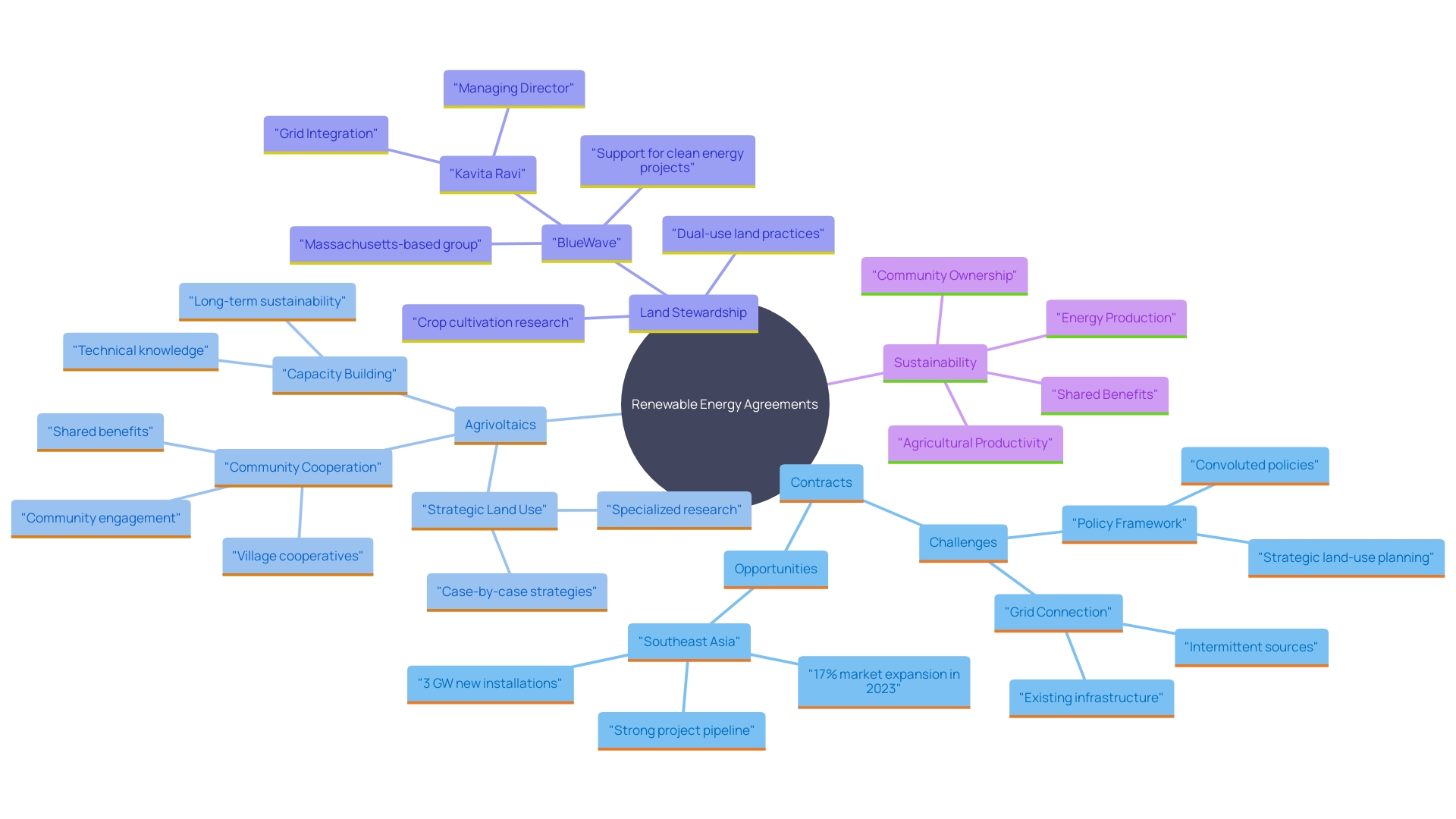
Benefits and Considerations for Landowners
Property owners can receive various advantages from engaging in renewable energy leases, such as a consistent revenue source, tax incentives, and the possibility of enhanced property value. According to the Solar Energy Industries Association, a utility-scale power plant may require between 5 and 10 acres per megawatt of generating capacity, with potential earnings ranging from $21,250 to $42,500 per acre annually. However, it's essential for property owners to consider factors such as usage restrictions, the effect on agricultural activities, and the long-term implications of hosting energy installations. Agrivoltaics, which pairs solar panels with agriculture, offers a unique opportunity to increase farm productivity by 35-73%, addressing multiple state priorities simultaneously, including clean energy generation and sustainable agriculture. Participating in comprehensive due diligence is essential to guarantee that the agreement aligns with the property owner's objectives and complies with the necessary regulatory stipulations, including zoning regulations, usage permits, and environmental evaluations. As observed by specialists, the growth of agrivoltaic initiatives is anticipated to encourage the sustainable use of terrain and reduce competition over cultivable areas, offering a much-needed increase in income for farmers.
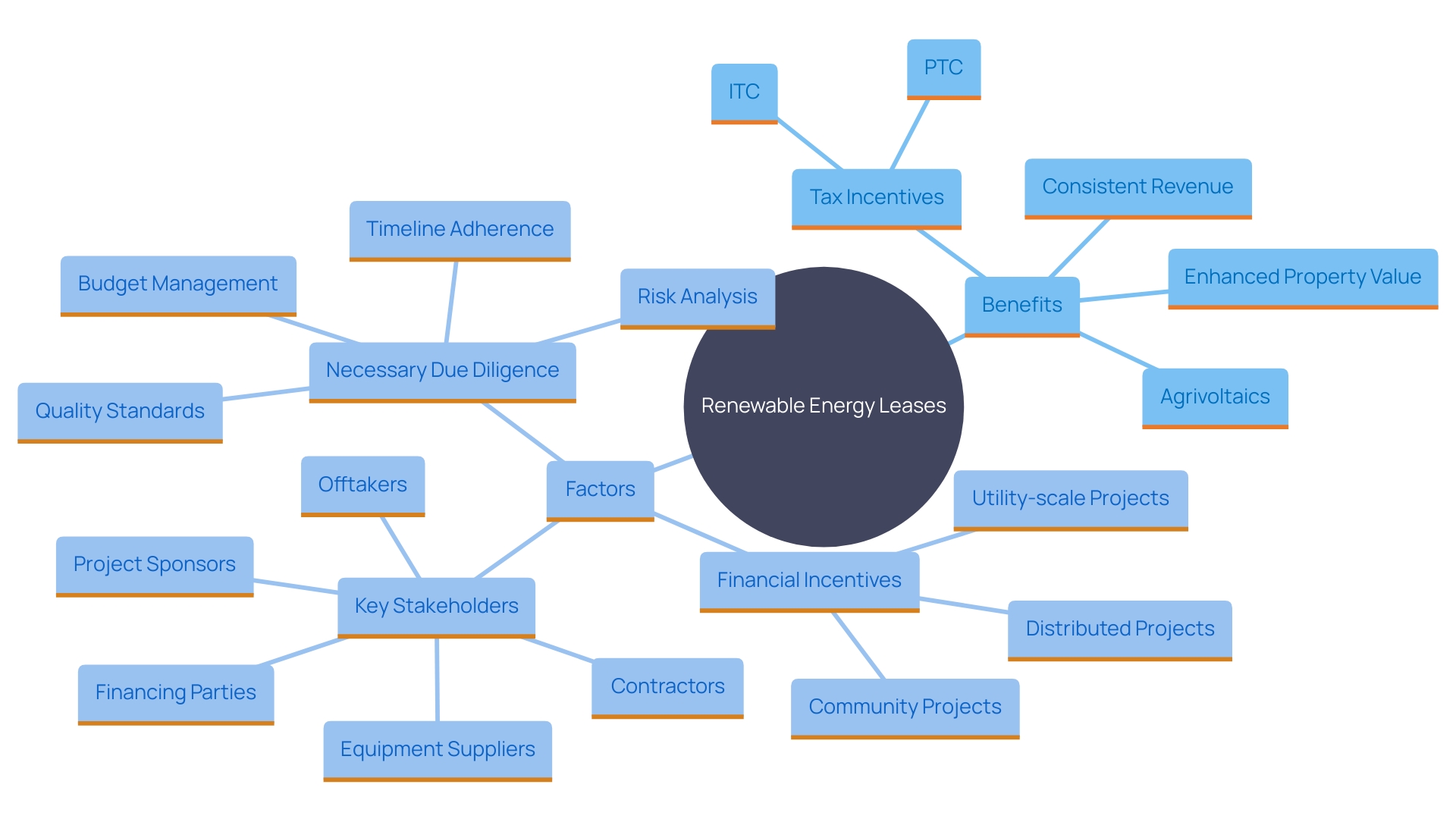
Phases of a Solar Land Lease Agreement
Setting up a land agreement for renewable energy entails several important stages, starting with preliminary conversations and bargaining. This stage sets the groundwork for the project, involving detailed conversations with landowners and stakeholders. For instance, the agreement between Noria Energy-Chaberton Energy and the Wolfe Neck Regional Wastewater Facility showcases how thorough negotiations can lead to a $2.3 million deal over 20 years for a floating panel system on 11 acres of lagoon, highlighting the importance of strategic planning and stakeholder engagement.
Following negotiations, drafting the lease agreement is essential. This legal document outlines the terms and conditions, ensuring all parties are clear on their responsibilities. As observed in the partnership between local authorities and industry groups such as SolSmart, effective information sharing and community involvement are essential for obtaining approval and promoting renewable energy projects.
Securing necessary permits is another pivotal phase. This step often involves interacting with local government and environmental regulators to meet legal and regulatory requirements. The Bureau of Land Management's recent policy revisions, opening 22 million acres of federal land for renewable energy development, illustrate the evolving landscape of regulatory frameworks, making it easier to secure permits for energy projects.
Ultimately, the setup and functioning of the energy facility signify the completion of the rental process. This phase requires meticulous coordination among various stakeholders to ensure the project's success. The Wolfe Neck project aims to reduce algae growth by shading the lagoon, demonstrating how photovoltaic installations can provide additional environmental benefits.
Every stage of the sunlight property rental procedure requires meticulous focus on specifics and cooperation among various parties, guaranteeing the effective execution and functioning of renewable power initiatives.
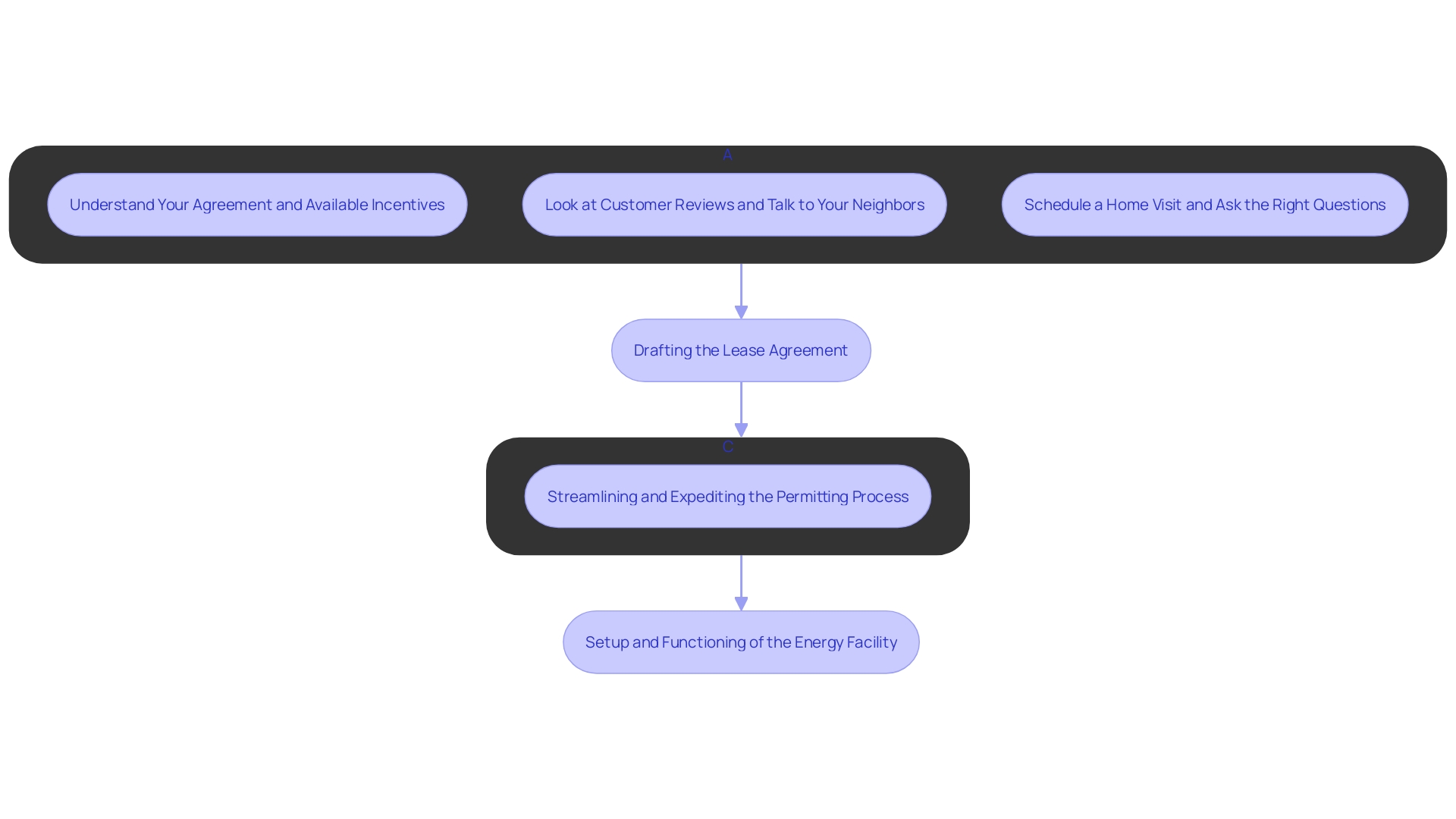
Negotiating Lease Payments and Terms
Negotiating lease payments and terms is crucial in land leasing for renewable energy. The payment frameworks are affected by various elements such as the scale of the installation, local power costs, and expected power generation. Larger energy farms, benefiting from economies of scale, can reduce costs per unit of electricity, impacting the overall payment structure favorably. For example, doubling the size of a renewable energy farm can significantly distribute many operational expenses across more photovoltaic panels, enhancing energy production and lowering unit costs.
Understanding market trends is crucial for landowners seeking competitive rates. The average cost of photovoltaic power purchase agreements in North America reached $52.69/MWh in the fourth quarter of 2023, the highest on record. This highlights the importance of staying updated with market conditions to secure advantageous terms. Transparency in negotiations is essential; engaging in open discussions about responsibilities and investments ensures that both parties benefit fairly.
Furthermore, the geographical location of the energy farm plays a critical role. Solar farms in sunny states like Arizona and California often report higher income per acre compared to those in less sunny regions, emphasizing the need to consider location during negotiations.
In summary, knowledgeable and open discussions, understanding market trends, and considering the scale and location of renewable energy farms can lead to more favorable and fair agreements.
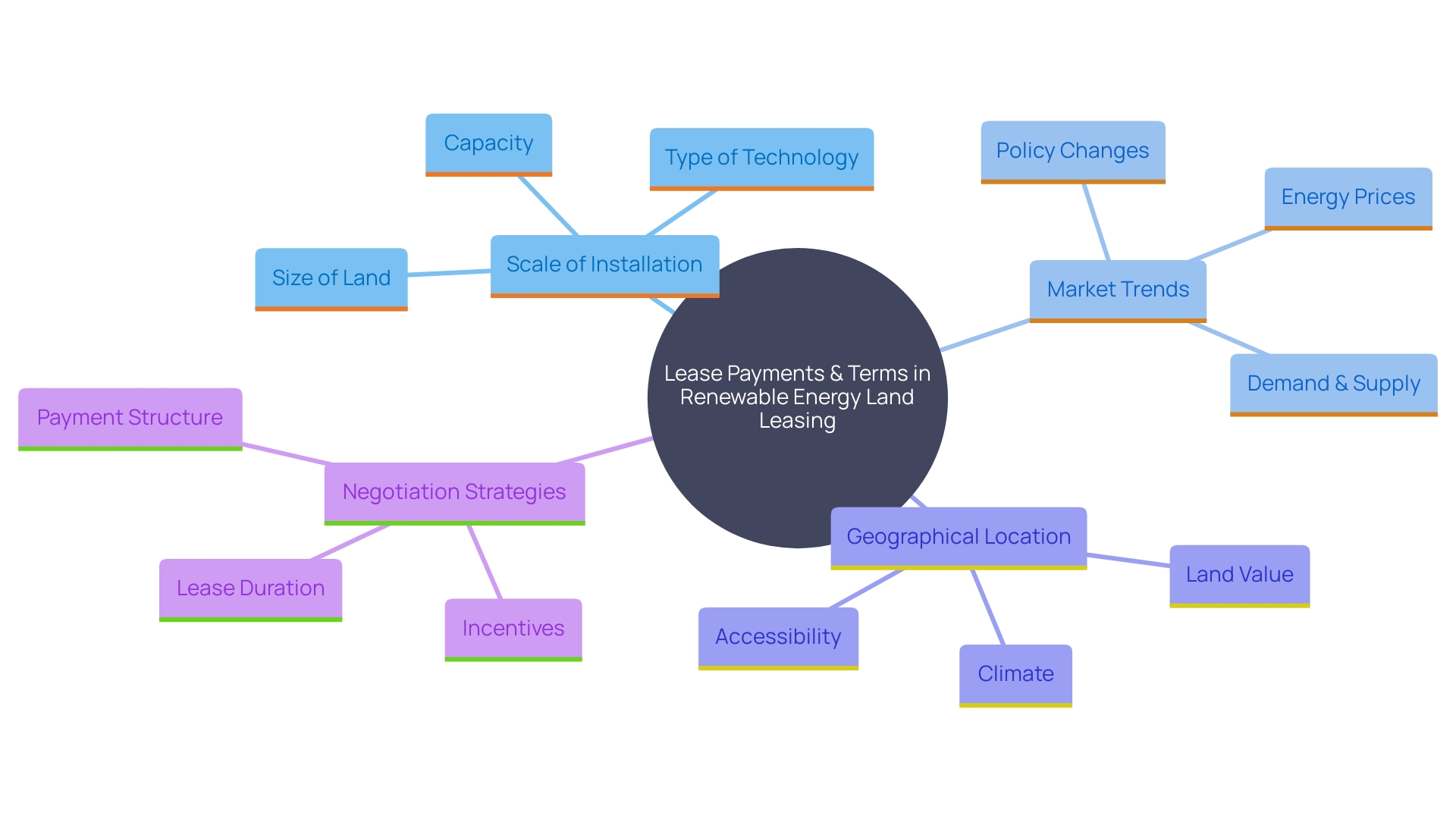
Regulatory and Legal Aspects of Solar Land Leases
Solar site leases are governed by a complicated framework of regulatory and legal requirements at local, state, and federal levels. Landowners and developers must adeptly navigate zoning laws, environmental regulations, and utility interconnection protocols. Adherence to these regulations guarantees the success of renewable energy initiatives and reduces potential legal conflicts. For example, the Bureau of Land Management (BLM) supervises over 245 million acres of public territory, administering it for renewable power initiatives. These projects, including solar, have the potential to add over 37 gigawatts of power to the western electric grid. The BLM's Draft Utility-scale Solar Energy Development Programmatic Environmental Impact Statement outlines five action alternatives for land use, showcasing the complexity and dynamic nature of regulatory landscapes. Furthermore, initiatives such as Massachusetts' expansion of net metering illustrate the changing regulatory landscape focused on encouraging renewable resource adoption. It is crucial for developers to work closely with local officials and municipalities to understand and communicate the benefits of renewable energy projects effectively, ensuring they align with community interests and regulatory standards. This partnership is essential in promoting sustainable energy solutions while maintaining the integrity and productivity of public areas.
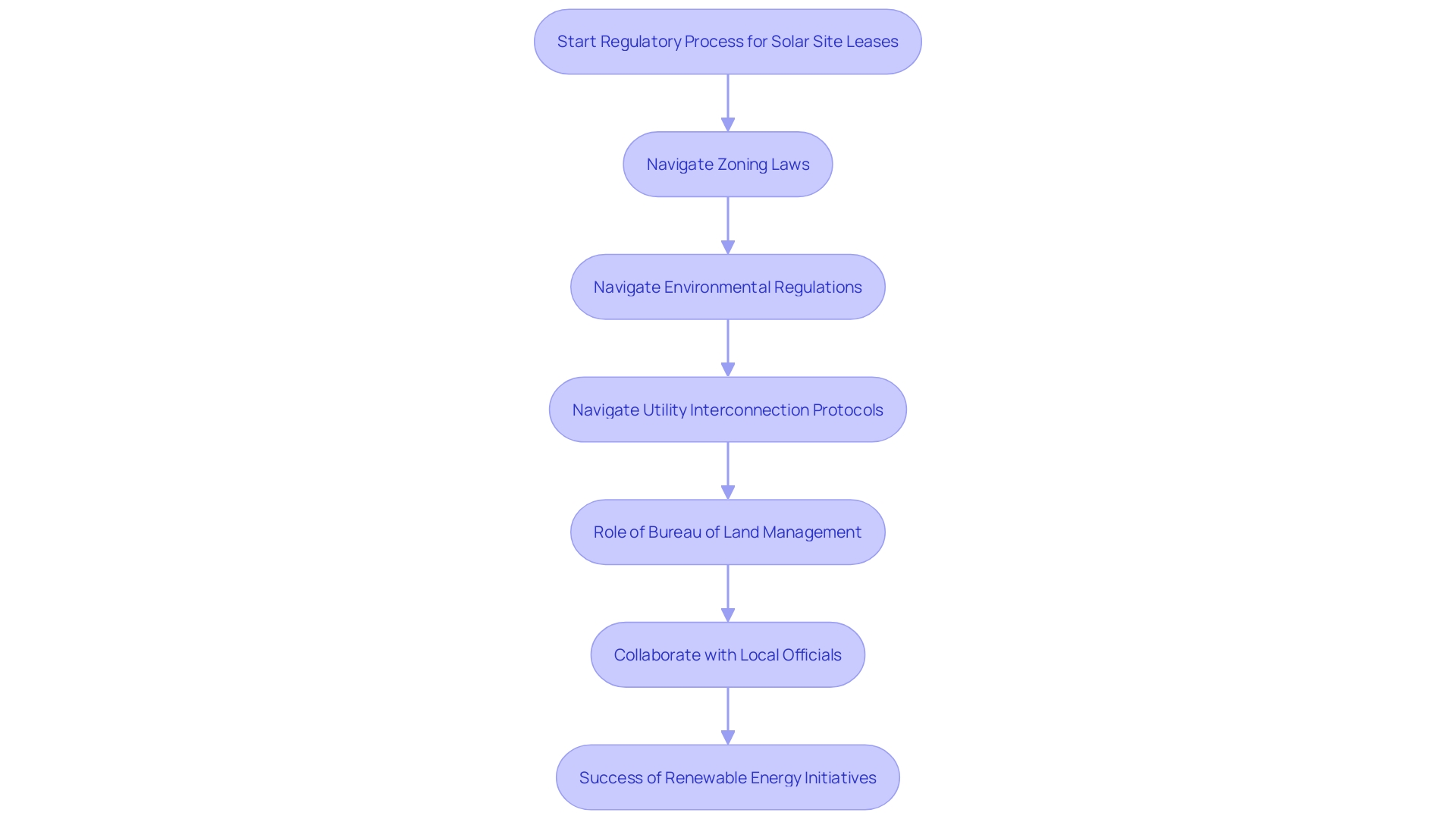
Decommissioning and Restoration at the End of the Lease
At the conclusion of a solar property agreement, decommissioning entails carefully taking away solar panels, racks, wires, and other equipment while implementing measures to return the area to its initial condition or another mutually accepted state. This phase should be clearly detailed in the rental contract to ensure that responsibilities are understood by both parties. Including stipulations for financial security bonds or site restoration bonds in the lease can safeguard against potential defaults or bankruptcies, ensuring the area is properly decommissioned.
State and local rules typically mandate that the developer or owner is responsible for the decommissioning process. For instance, North Carolina has implemented a statewide policy requiring owners to file and update decommissioning plans every five years, while proving their financial capability to cover the costs. As of the end of 2023, 20 states have enacted statewide policies, and 9 states have hybrid rules combining state and local regulations.
By incorporating these measures, property owners can protect their interests and promote responsible stewardship. Sufficient planning and legal protections can avert conflicts and guarantee that the area can be restored to its former use, whether for agriculture or other projects, contributing to a sustainable and economically advantageous future.
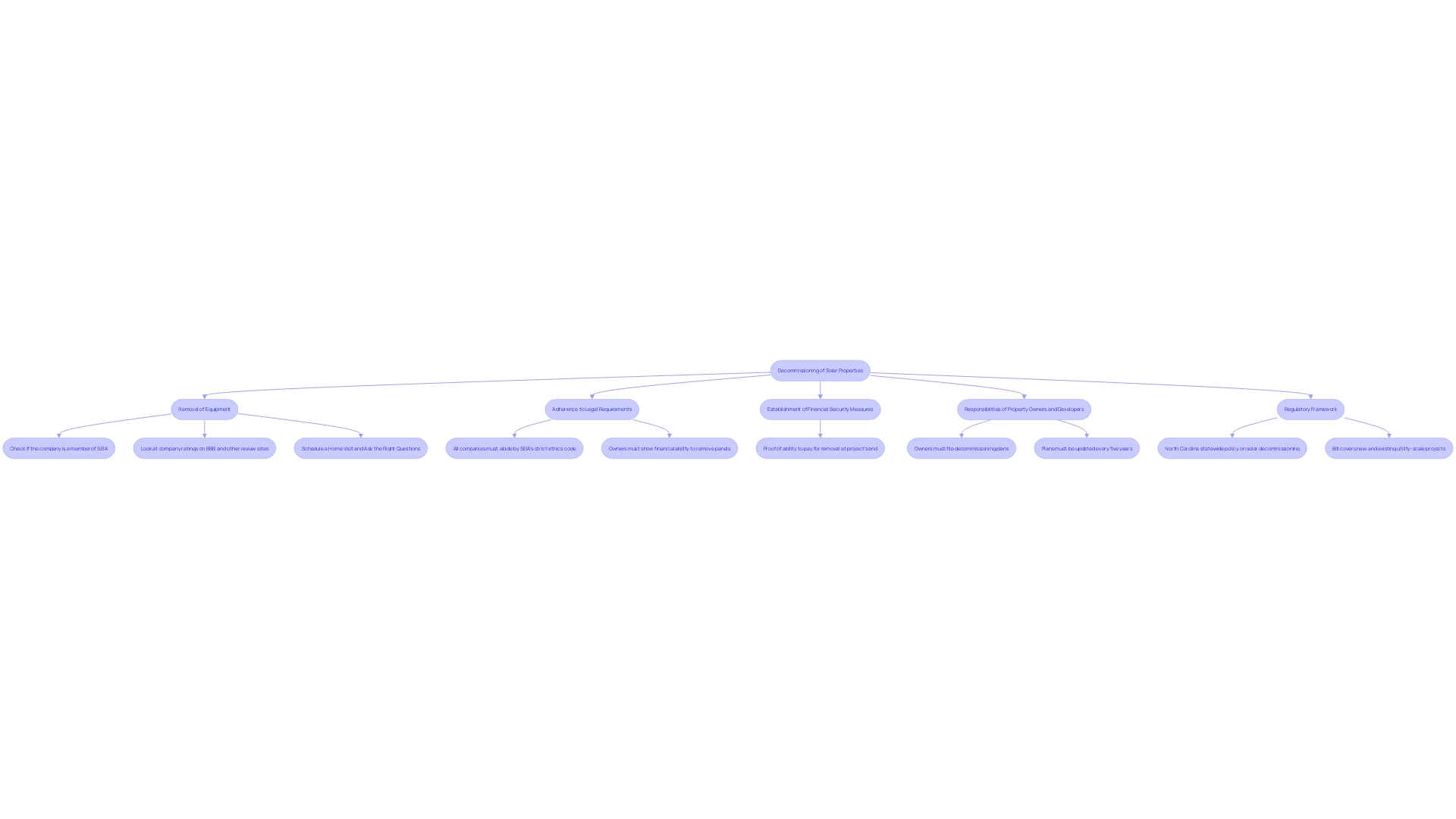
Best Practices for Landowners Entering Solar Land Leases
Property owners should conduct comprehensive research and participate in discussions with legal and financial professionals prior to entering into a solar land agreement. As stated by Garrett Mendelsohn, CEO of Solar Bootcamp, grasping the conditions and possible advantages of both rental agreements and power purchase contracts is essential, particularly taking into account the variations in payment arrangements. Best practices include soliciting multiple lease offers to compare terms and ensuring clarity in the agreement's scope.
A comprehensive approach to communication with energy developers is essential to address any complexities and safeguard the landowner's interests. This is particularly important given the potential for conflicts over land use, as highlighted by Kaitlyn Spangler, an assistant professor in Agricultural Economics, Sociology, and Education, who notes the tension between agricultural land use and solar farm installations.
By taking an active role throughout the lease's duration, landowners can better navigate these challenges and protect their interests. Maintaining open lines of communication ensures that they remain informed about any changes or updates, thus fostering a more secure and beneficial arrangement.
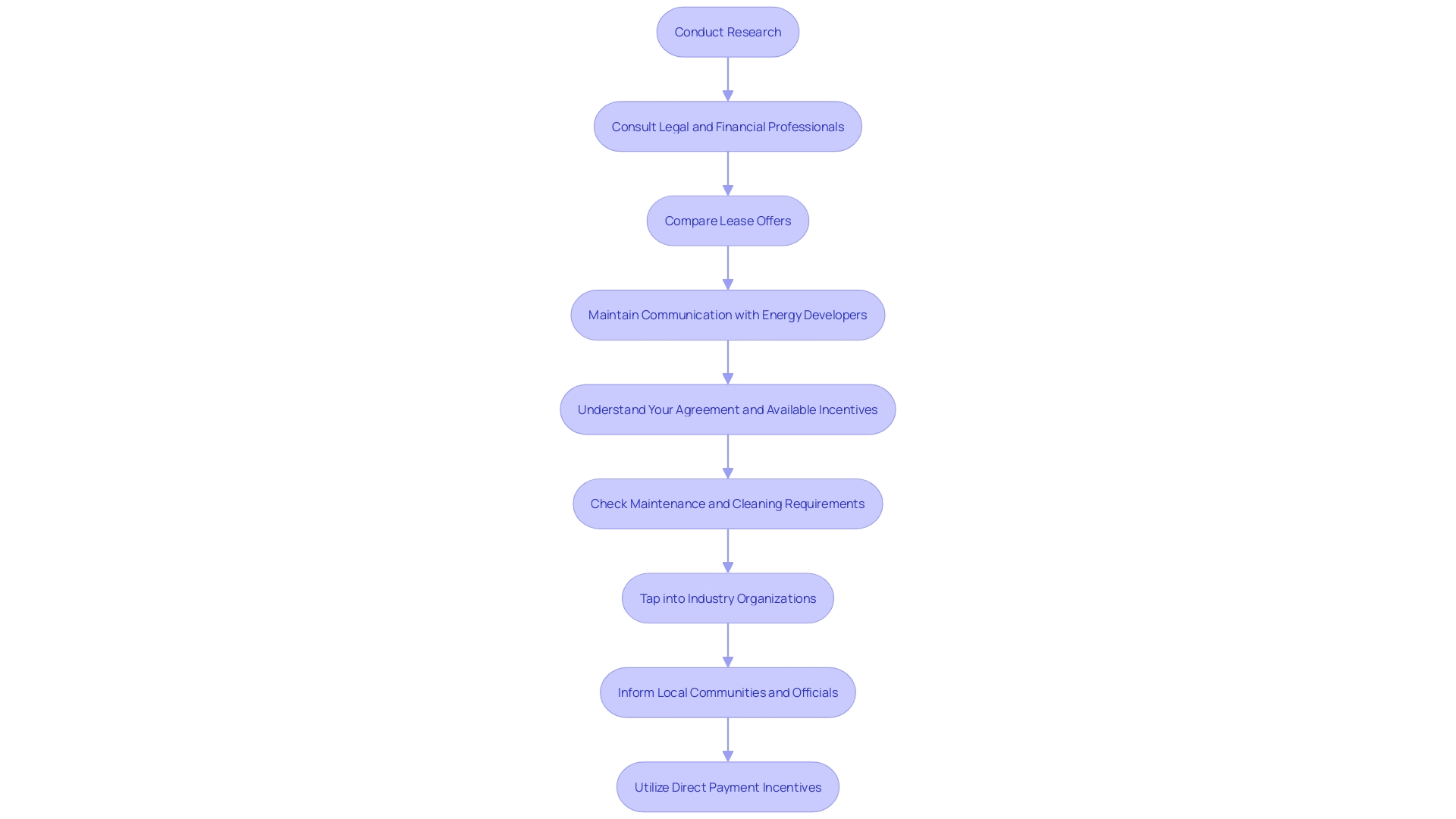
Conclusion
The exploration of solar land leases reveals their critical role in advancing renewable energy while balancing agricultural productivity and land conservation. These agreements, which define the relationship between landowners and solar developers, are structured to facilitate the efficient use of land for solar energy production. The integration of agrivoltaics stands out as a notable trend, allowing for dual land use that enhances both energy generation and agricultural outcomes.
Landowners benefit significantly from engaging in solar land leases, gaining financial incentives and potential increases in land value. However, careful consideration of the long-term implications and regulatory requirements is essential to ensure that these agreements align with their objectives. The phases of establishing a solar land lease, from negotiation to decommissioning, underscore the importance of strategic planning and collaboration among stakeholders, ensuring that projects are executed smoothly and responsibly.
Understanding the regulatory landscape is crucial for navigating the complexities of solar land leases. Compliance with local, state, and federal regulations not only facilitates project approval but also helps mitigate legal challenges. Moreover, the decommissioning process must be meticulously planned to ensure the land can be returned to its original state or another beneficial use, safeguarding the interests of landowners.
In conclusion, a comprehensive approach to solar land leases, characterized by informed negotiations, adherence to regulations, and proactive communication, is essential for maximizing benefits and ensuring sustainability. By following best practices and engaging with experts, landowners can navigate the complexities of these agreements and contribute to a greener future while preserving the integrity of their land.




